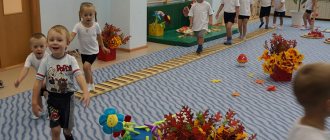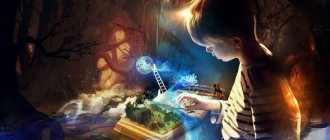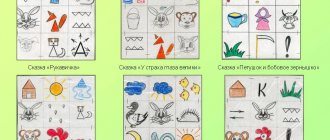Chance to become unique
In fact, from birth, every baby is initially gifted with the ability to fantasize, create, and imagine.
But over time, “good” fathers and mothers decide that their child does not need all this. Therefore, they begin to intensively develop logic and analytics in them, and teach them “useful and necessary for our harsh life.” But this is fundamentally wrong. Undoubtedly, a person who has a lot of useful knowledge and skills in life, no matter how harsh it is, will not be lost. But life will not be good either.
Therefore, by developing our baby’s imagination, feeding his fantasy, we give him an amazing chance to become a unique person.
conclusions
Children's clubs and kindergartens "Baby Club" use various methods and techniques to develop the child's imagination. Our classes are creative, personalized and help children develop their imagination through play and creativity.
Ability to make non-standard decisions
In the end, it doesn’t matter what profession he chooses or what life situations he finds himself in. A developed imagination will allow you to make non-standard decisions. And also to highlight nuances that are unnoticed by others, to look at any problem as if in 3-D format.
Thus, dear parents of a preschooler, right now you have a choice: do everything according to the rules.
- Teach to read, write, stand up for yourself, fight back, become independent, etc.
- Take a different path and raise an extraordinary, confident, and thinking person.
So, remember that “without imagination, there is no consideration” (folk wisdom).
Imagination - what is it like?
Research
In fact, you can’t even imagine how many scientific works have been written on this topic!
Moreover, venerable candidates and professors from pedagogy and psychology do not tire of endlessly developing this topic.
Almost all research in the field of children's imagination is aimed at finding new methods for its development, and how to speed up this process. Because everyone can’t wait to cram as many “useful things” into the child’s head as possible.
Finally, there are some unshakable definitions: types of imagination and its development at different ages of the child. And in order to move on, you need to understand these concepts.
Types of fantasy
Everything is simple here. Since young children do not have significant experience or knowledge in any areas. Therefore, all that they can fantasize about is either what was told by adults (other children) or what they read in children's books. Here is the simplest division of such fantasies:
- passive - something that will never come true (dreams, daydreams);
- active - something that needs to be implemented (in cases with children, this needs to be implemented right now);
- creative - not just a repetition of ideas already embodied by someone, but created independently;
- reproductive - using other people's ideas in one's own interpretation.
An example of reproductive fantasy is reincarnation into a fairy-tale character. This often happens after reading a book or watching a cartoon.
At the same time, a child, playing any hero, only first takes the prototype of his character.
Then he adds so much of his own and new things that the parents are only surprised: “where does it come from, the fairy tale was about something completely different!”
Categories of imagination
So, in this matter we are primarily concerned with the development of the active variety of imagination. And it is at one time divided into several categories:
- verbal - based on speech (inventing new words, selecting similar ones to already familiar ones, etc.);
- non-verbal – fantasies based on what has already been seen;
- musical – the ability to bring to life or verbally describe musical images;
- emotional – to embody or describe, transform into reality the emotional component of images and experiences;
- motor – the embodiment of fantasy forms using plastic movement.
In fact, the latter subtypes are quite conventional, for example, in a motor form (dance) one can express musical, emotional and any non-verbal images.
All of the above is a brief theory. It is not necessary to memorize it, but it gives us basic concepts that will be useful in the future.
Child's imagination and age
As an illustration, let us consider the development of imagination in a preschool child at different time stages and its features.
From 2.5 to 3 years
Until this time, the baby “observed”, accumulated knowledge (including language), skills and abilities. And now his time has come!
If you show your child the principles of playing with “dolls,” “cars,” “shop,” “hospital,” etc., imagination will receive the first impetus for development.
The baby will first act out already familiar situations, and then introduce his own emotional mood into them (joy, surprise, anger, etc.).
So, the task of parents is to teach role-playing games.
Up to 5 years
Development continues.
Parents complicate the task by adding construction sets, drawing (not individual elements - a house, a tree, a flower, but entire compositions, for example, “draw summer”, “draw a clearing”, “draw a street”), telling the child stories and writing fairy tales.
However, the baby must understand exactly where the realistic story is and where the fairy tale is.
Up to 7 years
A very important and responsible stage for parents. Right now, when a child graduates from kindergarten, he is entrusted with the responsibility of preparing for school, and then a new team, new rules, new high requirements.
At the same time, the imagination is so developed that any object is enough to build a whole world around it. A world in which there will be its own rules, its own criteria of “good” and “bad”, there will be no psychological pressure and the words “you must” .
And right now it is important not to let the child go into this imaginary, fantasy world. The child must be prepared for all changes gradually, at the same time showing how good reality is and the advantages of adult, school life.
Tips for parents
In the context of the above, the approach of child psychologists to such a phenomenon as the “imaginary friend” is interesting. Usually, parents get terribly scared when faced with such a “friend” of their child, and begin to intensively take measures to eliminate him.
On the other hand, psychologists assure that an imaginary friend of a 5-year-old child is not the same as the same friend of a 40-year-old woman. But this is a topic for another conversation. And we return to the development of the imagination of preschoolers.
Even if parents believe that their child must develop faster than his peers in all respects, they must still take into account age restrictions. Therefore, the task of fathers and mothers is not to overload their child. And to fully and productively use each time stage that has come.
Where to start for parents
To develop a little person’s imagination, you don’t need to spend a lot of time or money on additional classes with teachers. What can parents do?
- Tell interesting stories . Remember that the connection between generations was established through the transfer of information from older, experienced family members to younger ones. It is not necessary to use colorful, illustrated books or special manuals.
- It will be interesting for your child to hear a story from their parents on the way to kindergarten, before bed, or on a walk. Cautionary stories may be short, but they must be interesting and attract attention.
- Engage in creative activities . Together, draw, sculpt, make crafts from natural materials, and build from construction kit parts. There are many ideas on how to lure a little fidget. Give your child freedom to be creative. Let him draw with his fingers, cut out figures with children's scissors and paste them into an album, and make toys for the puppet theater. Tactile activities develop fine motor skills, and as a result of work, the child will be able to show creativity. Be sure to praise your child when he finishes his work. Hang the picture, even if it is drawn sloppily, in a prominent place or carefully place it together with other crafts.
- Use available tools . It is not necessary to use expensive paints, kinetic sand, or special creativity kits. Simple things that are always at hand also contribute to the development of children's imagination. For example, in a sandbox you can build a city out of sand, and make funny little animals out of cones and acorns.
- Control your viewing of cartoons . On gadget screens, children are offered ready-made solutions, and they do not need to think out, fantasize, or create anything. The baby needs to be provided with his own, personal space where he can realize his own fantasies. Unfortunately, parents often raise a child who is a consumer, not a creator.
Of course, it’s easier for mom to give the baby a tablet and calmly go about her business. But spend just an hour playing with your baby: look through a book together, draw, make figures from plasticine. It is important for a small child that his parents be nearby, offer activities, praise, and encouragement.
Developing imagination
Benefits
We're done with theory, let's move on to practice. So how can we develop imagination in children? First, let's see what the country's leading child psychologists offer on this issue.
- E. Kravtsova - believes that only an adult capable of “creatively leading” can teach a child to think creatively (quote from their book “Awaken the Magician in a Child”). A tandem is needed in which the adult plays the role of the main organizer and manager. If the parent does not have such abilities, professionals (educators, educators, teachers) should be involved.
- O. Dyachenko “Development of the imagination of a preschooler.” The book provides a complete overview on this topic: several methods for diagnosing imagination (at what level is it in a child), methods of development, progress and examples of specific activities for the development of creative and creative inclinations. An additional bonus is a lot of useful play exercises for all age categories.
- L. Vygotsky - insists on the close connection of imagination with personal experience. He believes that a child does not have his own creative perception and reproduction; everything is based either on what he has already seen or on what someone has told him.
- L. Subbotina - author, child psychologist, will be able to help parents much more than everyone else. She does not call for discrediting computer games, forcibly tearing a child away from the TV, consoles, and the ubiquitous Internet. She offers specific developmental play exercises, justifying their importance depending on age. A book that parents should read: “How to play with a child. Games for the development of motor skills, speech, attention, memory, thinking, perception, imagination in children from 3 to 10 years old" is not a scientific research, but a complete practical guide to action. You can read about games using this method for children under two years old and games for children under three years old on the blog (also follow the link for imagination games)
- A. Tsukar “Lessons in the Development of Imagination” - the manual is interesting because it is intended for practical use not only by adults (parents, teachers), but also by children themselves aged 9 to 17 years.
Recommendations
We hope that you are not going to raise your children by reading one single article, so we offer you this list of authors on the theory of imagination development in children (you can skip it, or read it for general development). As well as authors offering specific games and exercises (a mandatory guide to action).
And, as the “cherry on the cake,” Tsukar’s manual for independent study by a child. Imagine how much free time you will have! The main thing is to teach him by the age of 9 not only to read, but also to enjoy self-development (and this is not available to all adults).
Development of imagination by means of construction
There are many construction sets on sale that both children and adults enjoy playing with. Of course, there is no need to set complex design tasks for the child. But construction kits with proposed assembly schemes can be the start of an interesting hobby for a child. And if an adult gets involved in the design, then the design itself can turn into a game.
Design helps:
- develop spatial imagination,
- gain knowledge about shape, size, the first rudiments of knowledge about geometry,
- develop fine motor skills, which is useful for the development of thinking,
- develop independence, perseverance,
- develop imagination.
It will be useful for preschoolers to play with cubes, which will allow them to get a first idea of shape, color, size; mosaic, which teaches you to pay attention to little things; block constructors that create three-dimensional objects for games; Lego, with the help of which children become acquainted with 3D modeling skills.





